4 Easy Methods to Make Delicious Pulled Pork
4 Easy Methods to Make Delicious Pulled Pork – you can make it in the slow cooker, the oven, your Instant Pot, or even on the stove top! However you choose to cook it, this easy recipe makes pulled pork that’s perfect for sandwiches, wraps, nachos, and casseroles.
4 Easy Ways to Make Delicious Pulled Pork
Everybody seems to love tender and juicy pulled pork – at least in these parts they do. Because it’s easy to make, very economical, and also versatile, it’s made for lots of parties, gatherings, and wedding dinners.
I love to make a big pork butt on Saturday or Sunday so I can use the cooked meat the following week for making quick weeknight meals. To me, having cooked meat in my fridge when I start off the week gives me a lot of assurance (and less mental duress) that I will be able to feed my family in an easy, efficient way when they are clamoring for dinner.
When cooked pulled pork is available, you can easily make sliders, bbq pork sandwiches, tacos, wraps, pasta dishes, salads, casseroles….you name it. The options are pretty much endless and I love that when it comes to making supper.
Save this Recipe
Enter your email address and we will send you this recipe to your mailbox for easy reference! Plus, we will send you our latest recipes every week!
What to Love About Making This Easy Pulled Pork Recipe-
- No matter which method you choose to cook pulled pork, it’s very easy.
- When you make pulled pork, it yields a lot of cooked meat.
- You get to pig-out!!!
Alright. Let’s Jump In….
What is pulled pork? How do you pull pork? How do you make pulled pork from scratch?
Pulled pork is actually just shredded pork. You pull the pork by using two forks to shred the pork apart into thin strands so it’s easy to eat.
The best way to pull pork is by taking a fork in each hand, inserting them into the center of the hunk of pork you want to pull (shred), then drag the forks away from each other, pulling the tender pork away into chunks as you do so. Continue you working in the same manner with the cooked pork butt until you have a pile of pulled pork!
In the recipe card below, you will find 4 different ways you can make pulled pork from scratch. It’s sooooo easy.
Is it better to pull pork hot or cold?
Cooked pork butt or pork shoulder always shreds better when it’s warm. If you can’t shred the pork butt right after you’ve cooked it, and will have to chill it once the pork has cooled, slowly reheat it later before shredding it.
What cut of pork is recommended for making the best pulled pork? Can you use any cut of pork for pulled pork?
Where I come from, pork butt and pork shoulder are both highly regarded as the ideal cuts of pork for making flavorful and tender pulled pork that shreds easily.
Though the pork shoulder and the pork butt are cuts of meat that are one-on-top-of-the-other from the front shoulder area of the pig, technically they are different cuts of meat.
Wait. You’re saying that both the pork SHOULDER and the pork BUTT come from the same FRONT area of the pig?
Yep. Both of these cuts come from the front shoulder of the pig and are used interchangeably for making delicious pulled pork. Weird, huh?
So if pork butt doesn’t come from the butt of a pig, why in the heck is it called PORK BUTT?
I know, it’s all pretty confusing, that’s for sure. After some research, I discovered that the reason this cut is called pork butt is because “back in the day” butt was another name for a barrel. And at that time, because all pork shoulders were shipped inside of barrels, they were were referred to as pork butts.
To make matters even more confusing, butchers in Boston had a particular way of preparing pork butt, so eventually this cut became known as the “Boston Butt.”
**Please don’t kill the messenger here….I think it’s all pretty crazy, too. 🙂
What makes pork butt and pork shoulder the ideal cuts for pulled pork?
Pork butt and pork shoulder are high in juicy fat marbling and connective tissue, both of which are perfect for rendering tasty pulled pork. And, because the shoulder area of a pig gets a lot of use, this factor also contributes to great flavor as an end result.
Yes, pork butt and pork shoulder do have quite a bit more fat than other cuts of pork, but this is also what allows for such wonderful pulled pork.
When I’m at the meat case, there seems to be so many different names for pork butt and pork shoulder. Why does it have to be so confusing?
Yep. It’s true and I get frustrated sometimes too – that pile of pork butts and/or pork shoulders in the meat case is likely going to sport some of the following names:
- pork butt
- Boston butt
- blade roast
- shoulder roast
- shoulder butt roast
- picnic roast or picnic ham
But don’t let all these different names overwhelm you.
Instead, know this: As long as you are planning to cook any one of the cuts of pork listed above in a “low and slow” method to the internal temperature of 195 degrees F. and the pork is fork-tender when tested, you will enjoy delicious, tender, and juicy pulled pork.
For tender pulled pork, what is the recommended “low and slow” cooking method that’s best?
Due to all the great connective tissue and fat marbling in these cuts, both pork shoulder and pork butt need to be cooked slowly at a low temperature until the internal temperature reaches 195 degrees F.
A “slow and low” method of cooking pulled pork is essential for breaking down all the connective tissue and fat so the cooked pork can easily be pulled apart.
How will I know when the pork butt is 195 degrees F. at the center?
When roasts (whether pork or beef) are very fork-tender and the meat falls apart when you twist the fork after inserting it into the thickest part of the meat, this is a great indicator that the pork is fully cooked to a safe temperature and ready to eat.
However, so that you don’t overcook the pork and to bring peace of mind that the meat is indeed cooked to a safe internal temperature, an instant-read thermometer is a must.
How should I use the instant-read meat thermometer to check the internal temperature?
Insert the stem of the instant-read thermometer into the thickest part of the pork butt or hunk of pork butt, making sure not to touch any bones or the side of bottom of the pan. Wait for the dial to stop moving to indicate the internal temperature of the meat. It’s that easy!
I recommend having a second instant-read thermometer as a back up. Sometimes you may insert the stem into the meat and feel like the temperature reading just can’t be correct.
When that is the case, you can then insert the second thermometer to get a reading there to see if they agree. If they are both if proper working order, and you aren’t touching any bones or the bottom of the pan, they should both give the same internal temperature reading.
Just to verify, pork shoulder and pork butt can be used interchangeably for making pulled pork, correct?
Yep. On the pig, the pork butt is located on top of the pork shoulder and though they are technically two separate cuts of meat, they can be used interchangeably for making pulled pork.
Why does the recipe instruct to cut the pork butt into 4 large hunks?
This step is two-fold! First, 4 large hunks of pork butt will cook more quickly than one large pork butt. Secondly, cutting the pork into 4 large hunks is going to build flavor because you can season way more surface area with the spice rub this way.
What if I get home with a pork butt that has a bone in it? Does that matter?
Not really! Boneless pork butt is easier for cutting into large chunks for seasoning and browning the pork, but if you happen to choose one from the meat case that comes with a bone (it’s called the blade bone in case you’re wondering), that’s fine too.
Should I still cut the pork into chunks if it has a bone?
Yep, no worries. If you encounter a blade bone within the pork butt, simply work around it. I slice the meat away from the bone as best I can, cutting the pork into 4 hunks, one of which will have the bone attached.
FYI – Once the pork has cooked low and slow, the meat that’s attached to the bone will either have already fallen away into the cooking liquid or can easily be removed with your fingers once the pork has cooled.
Is it true that bones give meat more flavor?
Yes, and that’s why I never sweat it if my pork butt comes with a blade bone. A bone does make s bit more work when you’re cutting the roast into 3-4 large chunks, but any good cook will tell you that bones are actually worth the extra effort.
As the bone within the meat begins to heat up, the marrow inside the bone is released. Because the marrow is rich in fat and flavor, these marrow juices immerse themselves into the meat providing juicy, tender, and very flavorful pulled pork.
What do I need to look for when purchasing a pork butt?
Look for pork that is well marbled with lots of fat veins running throughout the muscle; the pork should be a rosy, reddish-pink pink in color.
How much pork butt should I purchase?
Great question. Due to the high amount of fat found in pork shoulder and pork butt, know ahead of time that these cuts will typically lose about 50% of their weight during cooking.
A generous serving of cooked pulled pork is considered 6 oz. per sandwich. “Butt” because I definitely want to make sure I have plenty of food AND some leftovers, I allow for 8 oz. of cooked pulled pork for each guest.
To know how much pork butt I’ll need to purchase to allow each person that 8 oz. portion of cooked pulled pork, I always do the math backwards.
Let’s say I’m expecting 10 guests:
- 10 guests x 8 oz. of cooked pork = 80 oz.
- Since the pork will reduce by half when it’s cooked, I know I’ll need to purchase 160 oz. (10 lbs.) of raw pork butt for my gathering.
- Based on this type of calculation, and to make it easier to remember moving forward to make more pulled pork, you can plan on 1 lb. of raw pork per person.
What ingredients are needed to make the ultimate pulled pork?
- Pork butt or pork shoulder
- Brown sugar
- Spices: smoked paprika, chili powder, cumin, red pepper flakes, granulated garlic, salt and pepper
- Chicken broth
- Honey
- Cider vinegar
- Ketchup
- Liquid smoke
What if I don’t have cider vinegar on hand? Can I leave this ingredient out of the recipe?
Please don’t leave the vinegar out of the pulled pork! The tangy-ness of cider vinegar really rounds out the sweet, spicy, perfect pulled pork flavors. Cider vinegar is very inexpensive and you can purchase it in small bottles.
*But just so you know, you could leave the vinegar out without ruining the pulled pork – it just won’t be as gooooood.
If I prefer not to cut the pork butt into chunks, can I cook the roast as a whole piece of meat?
Certainly. Just rub the spice rub all over the entire exterior of the pork butt using your finger tips. It will take longer to cook the pork butt as a whole, but just cook it until the internal temperature is 195 degrees F. at the center and the meat is very fork-tender when testing it towards the end of the cooking time.
If your goal is to cook a whole pork butt in an Instant Pot, you may need to use an 8 quart pot in order for the roast to fit properly, allowing for room inside the pot so the liquid can circulate in order to build pressure.
If you are cooking the pork butt as a whole roast, you will need to cook it longer. See the recipe for directions for times.
How do you know when the pulled pork meat is fork-tender? What does that mean exactly?
Fork-tender means that when you insert a fork into the thickest part of the meat and twist, the meat gives easily to the motion of the fork. If you insert the fork into the meat and you feel resistance (both going into the meat and when you twist) it’s not fork-tender.
Can other meats be pulled too?
Great question, and yes they can. Shredded (pulled) beef from a cooked roast or shredded chicken from cooked chicken breasts or thighs are also delicious!
Other Chicken and Meat Recipes to Enjoy
- Roast Pork Tenderloin and Sweet Potato Sheet Pan Dinner
- Pulled Pork Walking Tacos
- Easy Instant Pot Swiss Steak
- Pulled Pork Parfaits
- Loaded Pulled-Pork Sweet Potatoes
- Oven-Braised Beef Short Ribs
- Asian Meatball Sub Sandwiches
- How to Make Tender and Juicy Beef Tri-Tip
- How to Cook a Frozen Turkey Breast in Your Instant Pot – Just 5 Easy Steps!
- How to Cook Perfect Fool-Proof Prime Rib
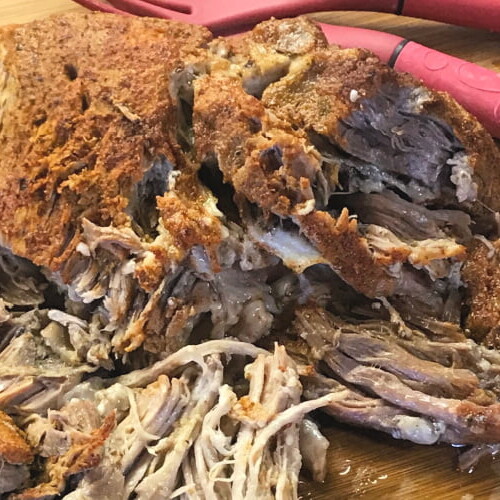
4 Easy Ways to Make Delicious Pulled Pork
Ingredients
- 4 lbs. pork butt or pork shoulder, cut into 4 large hunks
- vegetable or canola, for browning the pork
- 3 Tbs. smoked paprika
- 2 Tbs. mild chili powder
- 2 tsp. ground cumin
- 2 Tbs. kosher salt
- 2 tsp. black pepper
- 1/2 - 1 tsp. red pepper flakes
- 1 tsp. granulated garlic
- 1 - 8 cups chicken broth this amount depends on the method you choose for cooking the pork butt roast
- 1/2 cup honey
- 1/2 cup cider vinegar
- 1/2 cup ketchup
- 1/2 tsp. liquid smoke
Instructions
How to Season the Pork (for any chosen cooking method below)
- In a large mixing bowl, add all of the spices, including the salt and pepper, combining well; reserve. Place the pork butt or pork shoulder onto a cutting board; cut the pork into 4 large hunks. Add the hunks of pork to the prepared bowl of spice rub, working one at a time, rubbing the spice rub into the pork on all sides using your fingers tips; repeat with the remaining hunks of pork.
Instant Pot Method for Cooking Pulled Pork
- Using the saute setting on the Instant Pot, stir in 1 cup of chicken broth along with the honey, vinegar, ketchup, and liquid smoke, stirring to combine; add the seasoned pork hunks to the pot. You should be able to fit 4 lbs. of pork butt cut into hunks into the 6-quart Instant Pot. If you are cooking a pork butt as a whole roast (instead of cut into hunks as directed), you may need to use an 8-quart Instant Pot so there is adequate room. Also, if you are cooking a pork butt as a whole roast (instead of cut into hunks as directed) you will need to cook it for 15 minutes per lb. of meat, followed by a full natural release.
- Cover the Instant Pot, locking the lid into place. Choose the high pressure setting for 48 minutes (12 minutes per lb. of pork that has been cut into hunks), bringing the Instant Pot to full pressure. When the timer sounds, be sure to utilize the natural release method, letting the pressure naturally release from the Instant Pot on its own. **Please don't skip this step - the natural release method for cooking meats is absolutely essential for tenderness and a good eating experience. A quick release method when cooking meats doesn't work since the meat isn't given a chance to let the protein fibers rest so they can relax, causing the meat to be chewy and tough.
- When all the pressure is naturally released from the Instant Pot, carefully unlock and remove the lid, testing to make sure the pork is very fork-tender and shreds easily. If the pork isn't as tender as you prefer, bring the Instant Pot back up to full pressure again, cooking the pork for an additional 10-15 minutes (this is a the total time, not a per lb. time), followed by a 10 minute natural release. Fully cooked, tender, and safe-to-eat pulled pork will register 195 degrees F. at the center of the meat when temped with an instant-read thermometer at the end of the cooking time. However, if the pork is super tender and shredding apart with ease, you can rest assured that it is fully cooked.
- Using a slotted spoon, remove the hunks of pork to a large cutting board, letting the pork rest for a few minutes; shred the pork apart using two forks.
- **Please Note: The Instant Pot method of cooking the pork butt does not call for browning the pork first in this recipe as do the other methods of cooking shared below. However, you can definitely add this step if you so choose. I have discovered that when using this recipe to pressure the cook the pork, the browning step isn't necessary since the pressurization forces the flavors of the seasoning and the sauce into the meat in ways that other cooking methods cannot.
Slow Cooker Method for Cooking Pulled Pork
- In a large Dutch oven over medium high heat, add the oil; when the oil is hot, add the seasoned hunks of pork to the pot, working one at a time. Brown the pork on all sides, removing each one to a plate to repeat with browning the remaining pork; reserve. This step can be skipped, if preferred, to save time. However, the pork will be much richer and more flavorful if you brown it prior to cooking it in the slow cooker.
- Preheat the slow cooker using the low heat setting. Once the pork is all browned and reserved, remove most of the oil from the Dutch oven, leaving just the drippings for the most part. Over medium heat, add 2 cups of chicken broth, along with the honey, vinegar, ketchup and liquid smoke; whisk the ingredients to combine, deglazing the pot, then pour this mixture into the preheated slow cooker.
- Add the seasoned and browned hunks of pork to the mixture in the slow cooker, making sure the pork is at least one-third submerged in the liquid, adding more chicken broth if needed. Cover the slow cooker and cook the pork on low for 5-6 hours, or until it is very fork-tender.Fully cooked, tender, and safe-to-eat pulled pork will register 195 degrees F. at the center of the meat when temped with an instant-read thermometer at the end of the cooking time. However, if the pork is super tender and shredding apart with ease, you can rest assured that it is fully cooked. **Please Note: If you opt to cook the pork butt as a whole roast instead of cutting it into hunks, you will need to cook the pork for 7-8 hours on low in the slow cooker until it is fork-tender.
- Using a slotted spoon, remove the hunks of pork to a large cutting board, letting it rest for a few minutes, then shred the pork apart using two forks.
Stove Top Method for Cooking Pulled Pork
- In a large Dutch oven over medium high heat, add the oil; when the oil is hot, add the seasoned hunks of pork to the pot, one at a time. Brown the pork on all sides, removing each one to a plate to repeat with browning the remaining pork; reserve. This step can be skipped, if preferred, to save time. However, the pork will be much richer and more flavorful if you brown it prior to cooking it in the slow cooker.
- Once the pork is all browned and reserved, remove most of the oil from the Dutch oven, leaving just the drippings for the most part. Over medium heat, add 2 cups of chicken broth, along with the honey, vinegar, ketchup and liquid smoke; whisk the ingredients to combine, deglazing the pot.
- Add the reserved hunks of pork to the prepared mixture in the Dutch oven, making sure the pork is submerged by one-half; bring the liquids to a boil, then reduce the heat to a simmer. Simmer the pork over medium heat, covered or partially covered, for 3-4 hours or until the pork is very fork-tender. **Please Note: If you opt to cook the pork butt as a whole roast instead of cutting it into hunks, you will need to cook the pork for 5-6 hours until it is fork-tender.)
- Using a slotted spoon, remove the hunks of pork to a large cutting board, letting it rest for a few minutes, then shred the pork apart using two forks.
Oven Method for Cooking Pulled Pork
- Preheat the oven to 350 degrees F.
- In a large Dutch oven over medium high heat, add the oil; when the oil is hot, add the seasoned hunks of pork to the pot, a few at a time. Brown the pork on all sides, removing each one to a plate to repeat with browning the remaining pork chunks; reserve. This step can be skipped, if preferred, to save time. However, the pork will be much richer and more flavorful if you brown it prior to cooking it in the slow cooker.
- In the Dutch oven over medium heat, add 2 cups of chicken broth, along with the honey, vinegar, and liquid smoke, deglazing the pot as you whisk the ingredients together; return the reserved pork to the pot. If needed, add enough chicken broth so that the pork is submerged by one-half .
- Over medium high heat, bring the liquids in the Dutch oven to a boil; cover with the lid. Place the Dutch oven onto an oven rack placed into the lower third of the oven; cook the pork for 3-4 hours, or until it is very fork tender. Fully cooked, tender, and safe-to-eat pulled pork will register 195 degrees F. at the center of the meat when temped with an instant-read thermometer at the end of the cooking time. However, if the pork is super tender and shredding apart with ease, you can rest assured that it is fully cooked. **Please Note: If you opt to cook the pork butt as a whole roast instead of cutting it into hunks, you will need to cook the pork for 5-6 hours until it is fork-tender.
- Using a slotted spoon, remove the hunks of pork to a large cutting board, letting it rest for a few minutes, then shred the pork apart using two forks.

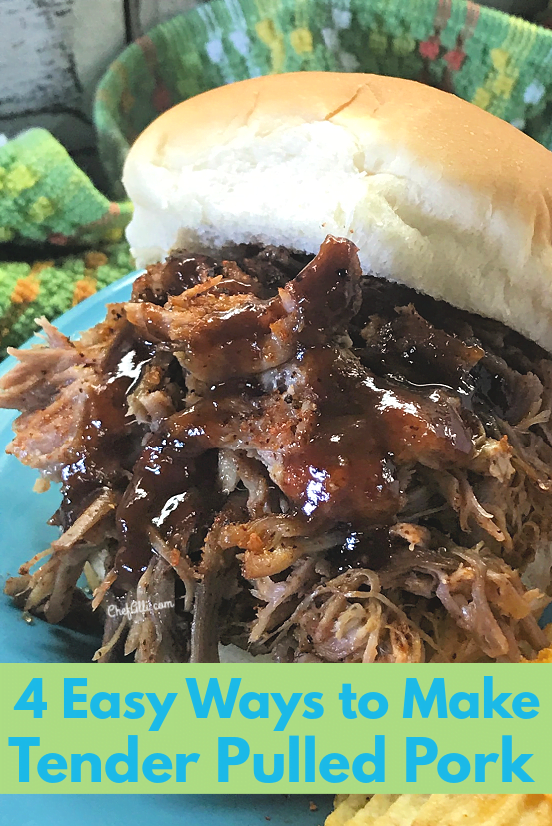
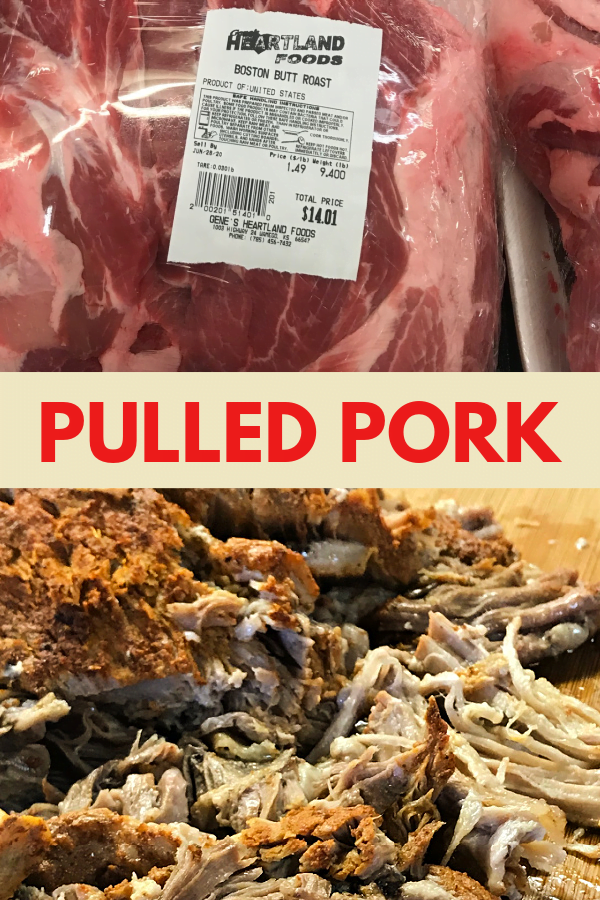
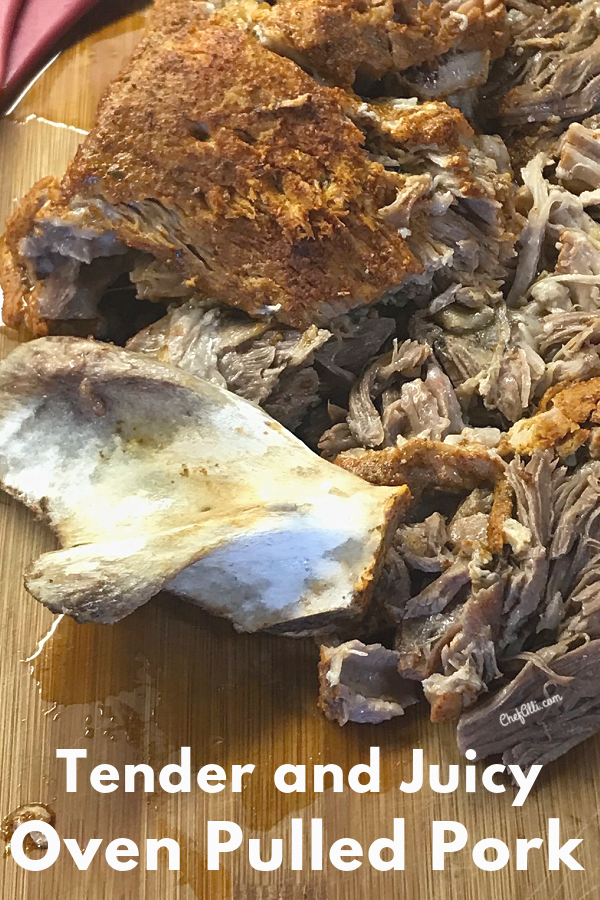
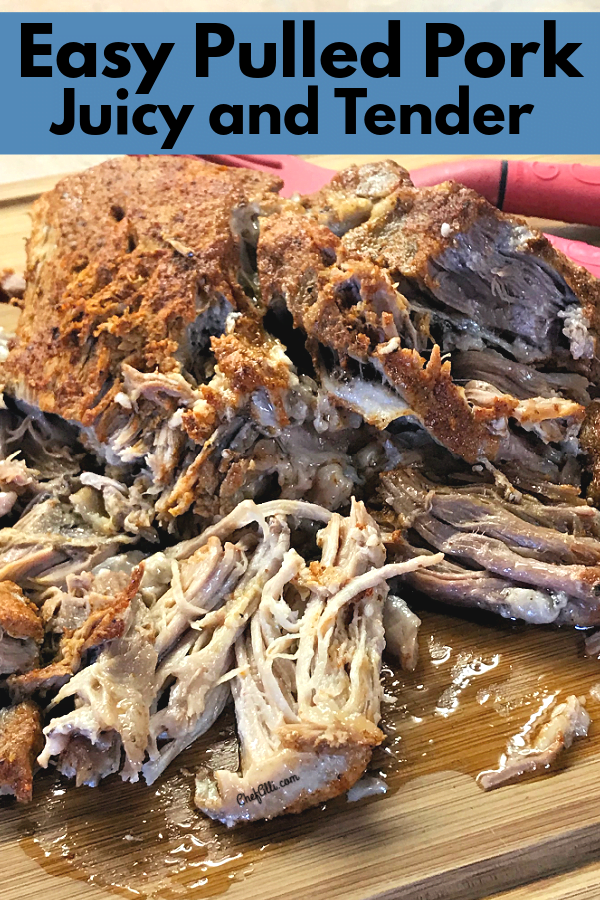
I’m on a very low salt diet, so I plan on using 2 Teaspoons of salt instead of 2 Tablespoons. Also will use reduced sodium Worcestershire Sauce. What do you think about substituting “no salt added” crushed tomato for catsup?
Hi Rich –
I think using crushed tomatoes for the catsup will work just fine. Please let me know what you think of this pork butt recipe – it’s one of our favorites.
Sincerely,
Chef Alli
looks delicious- I can imagine how soft and juicy the pork must be! 🙂